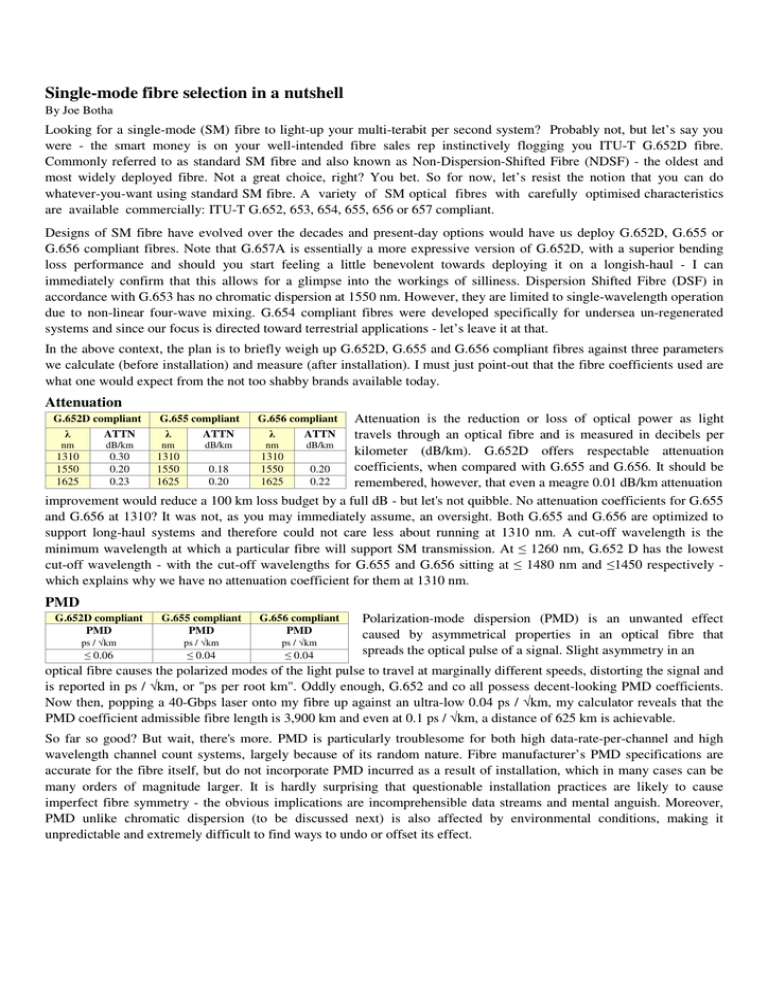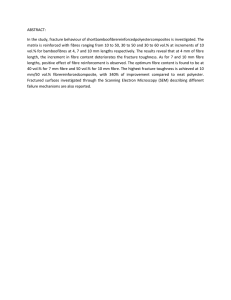Single-mode fibre selection in a nutshell
advertisement

Single-mode fibre selection in a nutshell By Joe Botha Looking for a single-mode (SM) fibre to light-up your multi-terabit per second system? Probably not, but let’s say you were - the smart money is on your well-intended fibre sales rep instinctively flogging you ITU-T G.652D fibre. Commonly referred to as standard SM fibre and also known as Non-Dispersion-Shifted Fibre (NDSF) - the oldest and most widely deployed fibre. Not a great choice, right? You bet. So for now, let’s resist the notion that you can do whatever-you-want using standard SM fibre. A variety of SM optical fibres with carefully optimised characteristics are available commercially: ITU-T G.652, 653, 654, 655, 656 or 657 compliant. Designs of SM fibre have evolved over the decades and present-day options would have us deploy G.652D, G.655 or G.656 compliant fibres. Note that G.657A is essentially a more expressive version of G.652D, with a superior bending loss performance and should you start feeling a little benevolent towards deploying it on a longish-haul - I can immediately confirm that this allows for a glimpse into the workings of silliness. Dispersion Shifted Fibre (DSF) in accordance with G.653 has no chromatic dispersion at 1550 nm. However, they are limited to single-wavelength operation due to non-linear four-wave mixing. G.654 compliant fibres were developed specifically for undersea un-regenerated systems and since our focus is directed toward terrestrial applications - let’s leave it at that. In the above context, the plan is to briefly weigh up G.652D, G.655 and G.656 compliant fibres against three parameters we calculate (before installation) and measure (after installation). I must just point-out that the fibre coefficients used are what one would expect from the not too shabby brands available today. Attenuation Attenuation is the reduction or loss of optical power as light travels through an optical fibre and is measured in decibels per nm dB/km nm dB/km nm dB/km kilometer (dB/km). G.652D offers respectable attenuation 1310 0.30 1310 1310 coefficients, when compared with G.655 and G.656. It should be 1550 0.20 1550 0.18 1550 0.20 1625 0.23 1625 0.20 1625 0.22 remembered, however, that even a meagre 0.01 dB/km attenuation improvement would reduce a 100 km loss budget by a full dB - but let's not quibble. No attenuation coefficients for G.655 and G.656 at 1310? It was not, as you may immediately assume, an oversight. Both G.655 and G.656 are optimized to support long-haul systems and therefore could not care less about running at 1310 nm. A cut-off wavelength is the minimum wavelength at which a particular fibre will support SM transmission. At ≤ 1260 nm, G.652 D has the lowest cut-off wavelength - with the cut-off wavelengths for G.655 and G.656 sitting at ≤ 1480 nm and ≤1450 respectively which explains why we have no attenuation coefficient for them at 1310 nm. G.652D compliant λ ATTN G.655 compliant λ ATTN G.656 compliant λ ATTN PMD G.652D compliant PMD G.655 compliant PMD G.656 compliant PMD ps / √km ps / √km ps / √km ≤ 0.06 ≤ 0.04 ≤ 0.04 Polarization-mode dispersion (PMD) is an unwanted effect caused by asymmetrical properties in an optical fibre that spreads the optical pulse of a signal. Slight asymmetry in an optical fibre causes the polarized modes of the light pulse to travel at marginally different speeds, distorting the signal and is reported in ps / √km, or "ps per root km". Oddly enough, G.652 and co all possess decent-looking PMD coefficients. Now then, popping a 40-Gbps laser onto my fibre up against an ultra-low 0.04 ps / √km, my calculator reveals that the PMD coefficient admissible fibre length is 3,900 km and even at 0.1 ps / √km, a distance of 625 km is achievable. So far so good? But wait, there's more. PMD is particularly troublesome for both high data-rate-per-channel and high wavelength channel count systems, largely because of its random nature. Fibre manufacturer’s PMD specifications are accurate for the fibre itself, but do not incorporate PMD incurred as a result of installation, which in many cases can be many orders of magnitude larger. It is hardly surprising that questionable installation practices are likely to cause imperfect fibre symmetry - the obvious implications are incomprehensible data streams and mental anguish. Moreover, PMD unlike chromatic dispersion (to be discussed next) is also affected by environmental conditions, making it unpredictable and extremely difficult to find ways to undo or offset its effect. CD 652D compliant λ CD G.655 compliant λ CD G.656 compliant λ CD nm ps/(nm·km) nm ps/(nm·km) nm ps/(nm·km) 1550 1625 ≤ 18 ≤ 22 1550 1625 2~6 8~11 1550 1625 6.0~10 8.0~13 CD (called chromatic dispersion to emphasise its wavelength-dependent nature) has zip-zero to do with the loss of light. It occurs because different wavelengths of light travel at different speeds. Thus, when the allowable CD is exceeded - light pulses representing a bit-stream will be rendered illegible. It is expressed in ps/ (nm·km). At 2.5Gbps CD is not an issue - however, lower data rates are seldom desirable. But at 10-Gbps, it is a big issue and the issue gets even bigger at 40-Gbps. What’s troubling is G.652D’s high CD coefficient - which one glumly has to concede, is very poor next to the competition. G.655 and G.656, variants of non-zero dispersion-shifted fibre (NZ-DSF), comprehensively address G.652D’s shortcomings. It should be noted that nowadays some optical fibre manufacturers don’t bother with distinguishing between G.655 and G.656 - referring to their offerings as G.655/6 compliant. On the face of it, one might suggest that the answer to our CD problem is to send light along an optical fibre at a wavelength where the CD is zero (i.e. G.653). The result? It turns out that this approach creates more problems than it is likely to solve - by unacceptably amplifying non-linear four-wave mixing and limiting the fibre to single-wavelength operation - in other words, no DWDM. That, in fact, is why CD should not be completely lampooned. Research revealed that the fibre-friendly CD value l i e s in the range of 6-11 ps/nm·km. Therefore, and particularly for high-capacity transport, the best-suited fibre is one in which dispersion is kept within a tight range, being neither too high nor too low. NZ-DSFs are available in both positive (+D) and negative (-D) varieties. Using NZ-DSF -D, a reverse behavior of the velocity per wavelength is created and therefore, the effect of +CD can be cancelled out. I almost forgot to mention, by the way, that short wavelengths travel faster than long ones with +CD and longer wavelengths travel faster than short ones with -CD. New sophisticated modulation techniques such as dual-polarized quadrature phase-shift keying (DP-QPSK) using coherent detection, yields high quality CD compensation. However, because of the added signal processing time (versus simple on-off keying) they require, this can potentially be a poor choice from a latency perspective. WDM multiplies capacity The use of Dense Wavelength Division Multiplexing (DWDM) technology and 40-Gbps (and higher) transmission rates can push the information-carrying capacity of a single fibre to well over a terabit per second. One example is EASSy’s (a 4-fibre submarine cable serving sub-Saharan Africa) 4.72-Tbps capacity. Now then, should my maffs prove to be correct, 118 x 40-Gbps lasers (popped onto only 4-fibres!) should give us an aggregate capacity of 4.72-Tbps? Coarse Wavelength Division Multiplexing (CWDM) is a WDM technology that uses 4, 8, 16 or 18 wavelengths for transmission. CWDM is an economically sensible option, often used for short-haul applications on G.652D, where signal amplification is not necessary. CWDMs large 20 nm channel spacing allows for the use of cheaper, less powerful lasers that do not require cooling. One of the most important considerations in the fibre selection process is the fact that optical signals may need to be amplified along a route. Thanks in no small part (get the picture?) to CWDM’s large channel spacing - typically spanning over several spectral bands (1270 nm to 1610 nm) - its signals cannot be amplified using Erbium Doped-Fibre Amplifiers (EDFAs). You see, EDFAs run only in the C and L bands (1520 nm to 1625 nm). Whereas CWDM breaks the optical spectrum up into large chunks - by contrast, DWDM slices it up finely, cramming 4, 8, 16, 40, 80, or 160 wavelengths (on 2-fibres) into only the C- and L-bands (1520nm to 1625nm) - perfect for the use of EDFAs. Each wavelength can without any obvious effort support a 40-Gbps laser and on top of this, 100-Gbps lasers are chomping at the bit to go mainstream. Making the right choice On the whole, it is hard not to conclude that the only thing that genuinely separates fibre types for high-bit-rate systems is CD. The 3-things - the only ones that I can think of - that is good about G.652D - is that it is affordable, cool for CWDM and perfect for short-haul environments. Top of the to-do lists of infrastructure providers pushing the boundaries of DWDM enabled ultra high-capacity transport over short, long or ultra long-haul networks - needless to say, will be to source G.655/6 compliant fibres. The cross-tab below indicates: Green for OK and oddly enough, Red for Not-OK ITU-T Compliant G.652 G.655/6 10-Gbps CWDM 40-Gbps CWDM 10-Gbps DWDM 40-Gbps DWDM 100-Gbps DWDM


